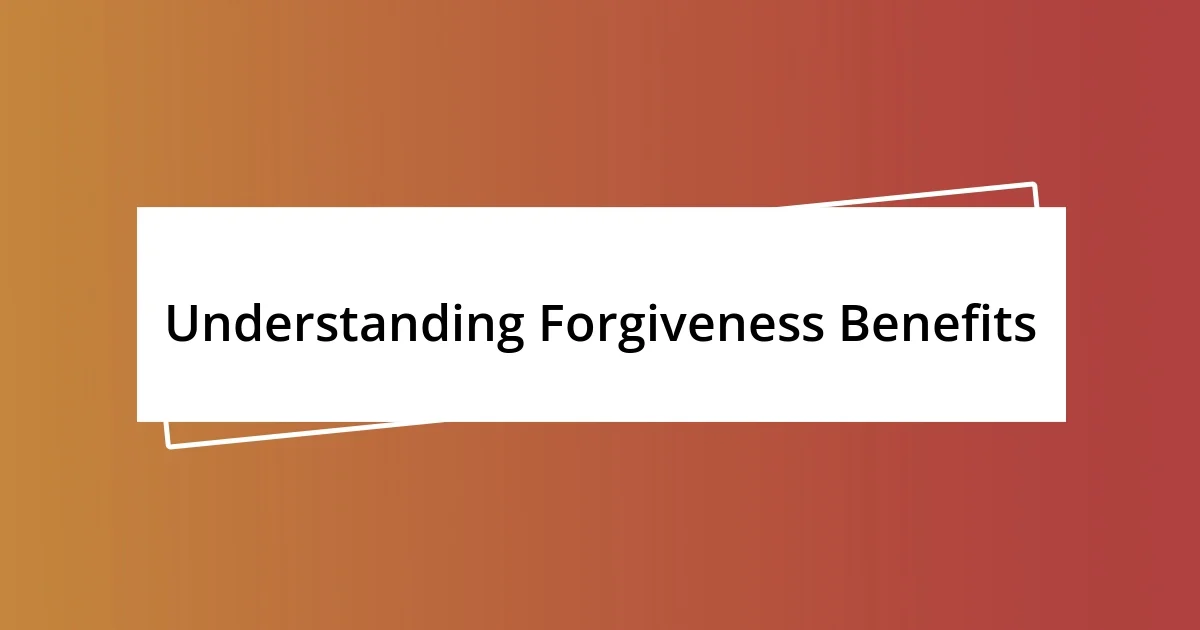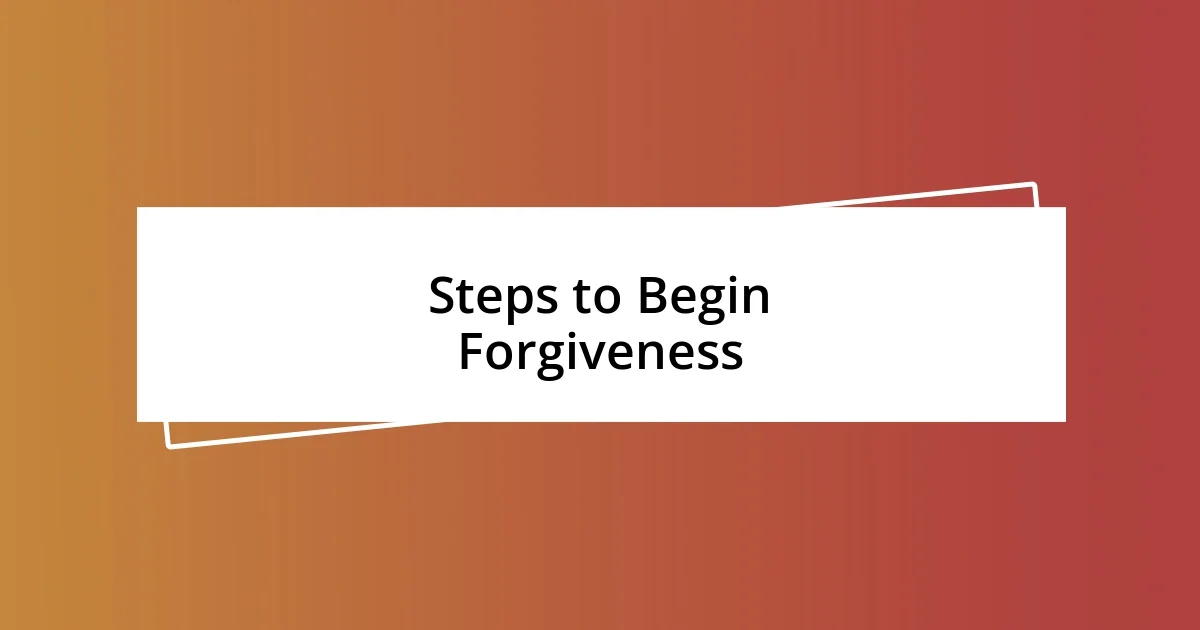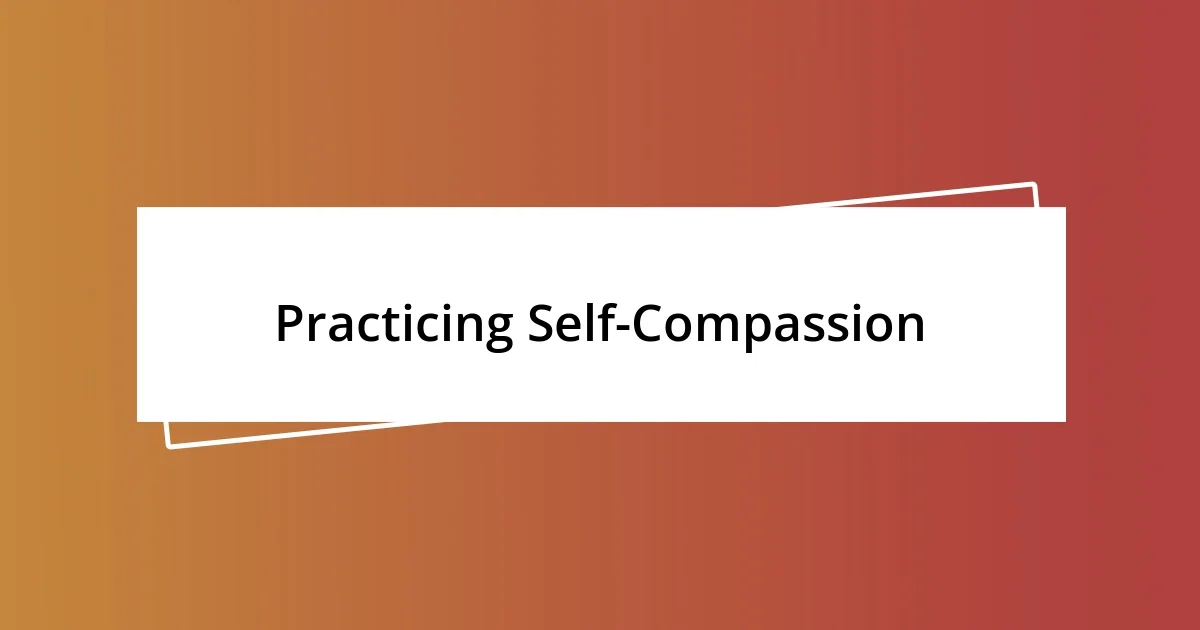Key takeaways:
- Forgiveness alleviates emotional and physical burdens, enhancing overall well-being and improving relationships.
- Recognizing the need for healing is crucial; common signs include persistent sadness, physical symptoms, withdrawn behavior, and ruminating thoughts.
- Embracing self-compassion and intentional practices, such as journaling and empathy, fosters a forgiveness mindset that promotes personal growth and emotional healing.

Understanding Forgiveness Benefits
Forgiveness can be a powerful catalyst for healing, both emotionally and physically. I remember a time when I held onto resentment toward a close friend who had let me down. As I slowly chose to forgive, I felt a weight lifted off my shoulders; I realized that holding onto anger was exhausting and counterproductive.
When I think about the benefits of forgiveness, I often reflect on how it frees us from the shackles of our past. Have you ever noticed how much mental energy is consumed by grudges? I found that once I embraced forgiveness, I experienced a lightness that improved my overall well-being. My stress levels decreased, and I was able to focus on the present rather than being bogged down by what once was.
Furthermore, forgiveness has been shown to improve our relationships with others, creating more space for love and understanding. I once observed this in my family when my parents reconciled after years of tension; their renewed connection breathed new life into our gatherings. It made me realize that forgiveness not only benefits those directly involved but also the loved ones who care about them.

Recognizing the Need for Healing
Recognizing the need for healing can often feel like an awakening moment. I recall a period when I was trapped in a cycle of negative thoughts after experiencing a heartbreak. It became clear that my relentless focus on the pain kept me from moving forward. Noticing that I was gravitating towards isolation instead of connection was a pivotal sign that healing was essential for my well-being.
Here are some indicators that you might need to prioritize healing:
- Persistent Sadness: Feeling overwhelmed by sadness that doesn’t seem to lift.
- Physical Symptoms: Unexplained aches, fatigue, or changes in appetite.
- Withdrawn Behavior: Avoiding social interactions and activities you once enjoyed.
- Restlessness: A constant sense of unease or agitation that disrupts your peace.
- Ruminating Thoughts: Being stuck on past events or grievances that replay in your mind.
Recognizing these signs in my life motivated me to seek help, whether through self-reflection, seeking advice from friends, or even professional support. Embracing the process of healing is not just a journey; it’s a commitment to rediscovering myself.

Steps to Begin Forgiveness
When it comes to beginning the journey of forgiveness, acknowledging your feelings is paramount. I vividly remember feeling a mix of anger and betrayal, and it took time for me to sit with those emotions. This process of reflection allowed me to understand why I felt the way I did, providing clarity on what I truly needed to forgive.
The next step involves making a conscious decision to forgive. I recall standing in front of a mirror, literally telling myself, “I choose to let this go.” It was a powerful moment—one that acted as a beacon guiding me toward healing. This declaration can be deeply personal; I’ve found that writing a letter to the person I needed to forgive—whether I sent it or not—was immensely therapeutic.
Finally, take small actions to reinforce your decision. Sometimes, when launching a forgiveness practice, I would visualize releasing my grudges as if they were balloons floating away. This practice helped me cultivate a sense of peace and allowed me to focus on the positive aspects of my life, which often included reconnecting with others or pursuing hobbies that I had neglected.
| Step | Description |
|---|---|
| Acknowledge Your Feelings | Reflect on the emotions you’re experiencing and understand their impact on you. |
| Make a Conscious Decision | Decide to forgive, expressing this commitment verbally or in writing. |
| Take Small Actions | Engage in rituals or practices that symbolize letting go of grudges. |

Overcoming Emotional Barriers
Overcoming emotional barriers can sometimes feel like scaling a steep mountain. I remember a time when my fear of vulnerability held me back from forming deeper connections with others. I found myself asking, “What if they reject me?” Ultimately, I realized that this fear was my own barrier, limiting my potential for joy and understanding in relationships.
It’s interesting how our past experiences can build walls around our hearts. I often catch myself reflecting on that moment when I chose to share my true feelings with a close friend. The initial anxiety was overwhelming, yet when my friend responded with empathy, I felt those walls begin to crumble. That experience taught me that sharing my emotions not only fostered connection but also began to heal those emotional wounds I had been carrying.
Emotional barriers can manifest in various ways—perhaps you find yourself constantly second-guessing your worth or avoiding confrontational situations because of past hurt. I’ve realized that recognizing these patterns is crucial. I once kept replaying a failed friendship in my mind, thinking, “If only I had done this differently.” It wasn’t until I shifted my focus towards self-compassion and understanding that I began to let go of the guilt, allowing myself to move forward with a clearer mindset. Empowering ourselves to confront and dismantle these barriers is a vital step toward true healing.

Practicing Self-Compassion
Practicing self-compassion is often a game-changer in our healing journeys. I remember a period when I was unusually hard on myself, constantly critiquing every mistake I made. One day, I found myself asking, “What would I tell a friend in this situation?” This simple shift transformed my internal dialogue, allowing me to replace self-criticism with understanding and patience.
Engaging in self-compassion means recognizing that being human involves making mistakes. I had a moment where I stumbled during a presentation—my heart raced with embarrassment. Later, I decided to treat myself with kindness rather than shame, reminding myself that everyone falters sometimes. Embracing this gentle perspective allowed me to learn from the experience without letting it define my self-worth.
It’s paramount to indulge in self-care activities that nourish your body and spirit. I often set aside time for hobbies that bring me joy, like painting or hiking. When I immerse myself in these activities, I realize that prioritizing my well-being isn’t selfish; it’s crucial. I encourage you to explore what self-compassion looks like for you, whether it’s a soothing bath or simply taking a moment to breathe deeply. Embracing kindness towards ourselves can be an incredible pathway to healing.

Creating a Forgiveness Mindset
Creating a forgiveness mindset involves intentionality and reflection. I recall a moment of deep frustration when a friend let me down, and my immediate reaction was to hold onto that anger. I started asking myself, “What would it take for me to forgive?” This question opened the door to understanding the weight of my resentment and how it affected my peace of mind.
One practice that truly helped me shift towards forgiveness was writing letters, even if I never intended to send them. I remember pouring my heart out on paper after feeling wronged. The act itself was cathartic; I felt lighter as I released my emotions. It’s fascinating how expressing our feelings can transform our perspective, allowing us to see the situation from a place of compassion rather than hurt.
As I continued on this journey, I learned to recognize the power of empathy. Reflecting on the fact that we are all imperfect beings was enlightening. I often find myself thinking, “If I can stumble and be forgiven, why shouldn’t I extend that same grace to others?” Cultivating this mindset makes it easier to dismantle grudges and embrace the process of letting go. Each small step in forgiving not only liberates us but also fosters healing in our lives.

Embracing Growth Through Forgiveness
Embracing growth through forgiveness has been a significant turning point in my life. There was a time when I held onto a grudge against a family member, convinced that my resentment justified my pain. It wasn’t until I saw how this was spilling over into my daily interactions, leaving me drained and irritable, that I realized holding onto bitterness was hindering my happiness. Why do we often cling to grudges like they’re precious treasures? I learned that rather than holding onto them, I could choose to let go and, in doing so, free myself from unnecessary anguish.
One pivotal moment for me was when I decided to confront my feelings head-on instead of avoiding them. I vividly remember sitting in my favorite coffee shop, sipping a warm latte, and scribbling in my journal about the emotions tied to my hurt. The act of writing nearly felt like a conversation with an old friend. As I expressed my pain, I found clarity not only in my feelings but also in understanding the other person’s perspective. This realization made forgiving them seem less about their actions and more about reclaiming my peace. Isn’t it liberating to recognize that forgiveness can start as an inner dialogue, enabling growth and emotional healing?
In moments of reflection, I often ask myself how far I’ve come in my journey with forgiveness. A few years back, letting go of past grievances felt impossible, but now, I embrace it as an essential part of my growth. I feel a shift within me when I consciously choose to forgive—it’s as if each act of forgiveness builds a bridge to a more profound sense of peace. The more I practice this, the more I’m convinced that forgiveness isn’t merely an act of kindness; it’s a powerful catalyst for healing that helps us blossom into our best selves.













